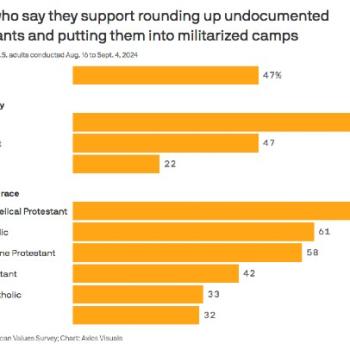I came across this old post from just after the 2008 election and it seems pertinent 11 years later, so I’m going to repeat it here. It is, in part, an expression of relief that Palin-ism didn’t win the day in 2008 — that a fear-driven message that manufactured and nurtured neurosis in the electorate was, briefly, held at bay.
It’s a depressing post to re-read now as it outlines the hope for necessary next steps — steps that were obstructed and prevented and denied at every point for eight years, laying the groundwork for the triumph of fear and neurosis in 2016. But I think what we discussed here a decade ago is still true, and more urgently true, and worth revisiting now.
Temple Grandin was on NPR’s “Fresh Air” last week.
Grandin, a professor at Colorado State, looks at the world with a different perspective than I do. I don’t mean that figuratively. Grandin, who was diagnosed as autistic in 1950, really does see and experience the world differently than neurotypicals like myself.
As she and radio host Terry Gross discussed her latest book, Animals Make Us Human (co-written with Catherine Johnson), they touched on the subject of animals exhibiting compulsive, repetitive behaviors — what Grandin called stereotypy. Figuring out what animals are thinking or feeling and how to address their concerns is kind of Grandin’s thing.
In the example of pet gerbils compulsively digging, digging, digging in the corners of their aquariums, Dr. Grandin said that the gerbils are motivated by fear:
What the gerbil really wants is a place to hide, because it’s a prey species animal and he’s trying to dig a hole in the bottom of the aquarium and he can’t make a tunnel. If you give him a tunnel, even a fake one, he’ll go in there. That gives him cover. He’s digging because he feels exposed. That stereotypy was motivated by fear.
Grandin also discussed another case of compulsive animal behavior — a polar bear named Gus who had taken to pacing back and forth in his zoo habitat. Gus’ behavior, Grandin said, was motivated by “seeking.” Being both very intelligent and a predator, Gus was simply going out of his mind with boredom.
That term “seeking” was new to me in this context. Dr. Grandin explained that she was using the terminology of Panksepp’s core emotions — fear, rage, separation anxiety, and seeking.
Those of you who majored in psychology or in veterinary science probably already knew all about Jaak Panksepp’s framework of core animal emotions, but this was new to me and it got me to thinking.
It got me to thinking, actually, about the 2008 presidential campaign.
Panksepp’s categories seem to me to provide a convenient, and insightful, shorthand for the contrast between the campaigns of Democratic presidential candidate Barack Obama and Republican vice-presidential candidate Sarah Palin. As in every campaign, both of those candidates touched on a wide variety of themes and topics and expressed a host of moods, tones and characteristics, but it’s still possible to summarize the overall gist of both. In Panskepp and Grandin’s terms: Obama appealed to seeking; Palin appealed to fear.
I regard this as yet one more reason to be happy and relieved that Obama won.
I also think that this insight of Panskepp by-way-of Grandin suggests a way of reaching — of persuading and perhaps even converting — those Palin supporters we spent the late summer watching at those rallies and in all of those disturbing YouTube videos.

What I’m trying to say here is a bit tricky, because it involves to some extent comparing those Palin supporters to Grandin’s neurotic gerbils, and I don’t suppose anyone likes being compared to neurotic gerbils. And it probably doesn’t help that I’m prefacing this by saying that I mean no offense in comparing them to neurotic gerbils. But I find the comparison illustrative, so here goes.
The core of Palin’s campaign was an appeal to fear. Her supporters found this appeal appealing because they were afraid.
But I don’t think that they started out afraid of the same things that Palin wanted them to be afraid of — immigrants and gays and commies and black people and Islamofascists and babykillers. I think they started out with more reasonable fears of things that really threatened their lives and livelihoods.
It makes sense to be afraid if your life lacks security — if you’re one paycheck or one illness away from losing your home, if the rules aren’t clear and they’re constantly changing and seem to be stacked against you, if you’re barely treading water and you’re not sure how much longer you can keep it up. Faced with that kind of insecurity, that kind of exposure to chance and risk and catastrophe, it makes sense to long for cover. Palin offered her supporters the illusion of cover — like the fake tunnel that reassures the neurotic gerbil. That offer was attractive, but it ultimately doesn’t help them. It can’t really make them unafraid.
More essentially, the core audience at Palin’s rallies seemed to be made up of people who had come to regard themselves as a prey species of animal. These are people, that is to say, who have come to feel that they are not in charge of their own lives or their own fates — that they’re acted on more than they are free to act.
That suggests two strategies for reaching out to them and helping them. First, per Dr. Grandin, we have to find ways to make them feel more secure and less exposed. We need to respond to the fear they’re exhibiting by providing cover, providing shelter. That’s the prescription for a prey species of animal.
But of course these people are not a prey species of animal, not really. And thus we have the second, necessary strategy for reaching out to these folks: Convincing them that they’re not at the bottom of the food chain. To fully convince them of that requires us to ensure that no one is treated as prey. That means restraining would-be predators and offering everyone substantial protections and not just fake tunnels or the sham security of scapegoating.
Building a society in which no one is treated as prey is a noble goal, but not an easy one. The good news here, as the Obama campaign illustrated, is that we humans also have this core emotion of seeking. We want to be called to work for noble goals, especially when they’re not easily achieved.
















